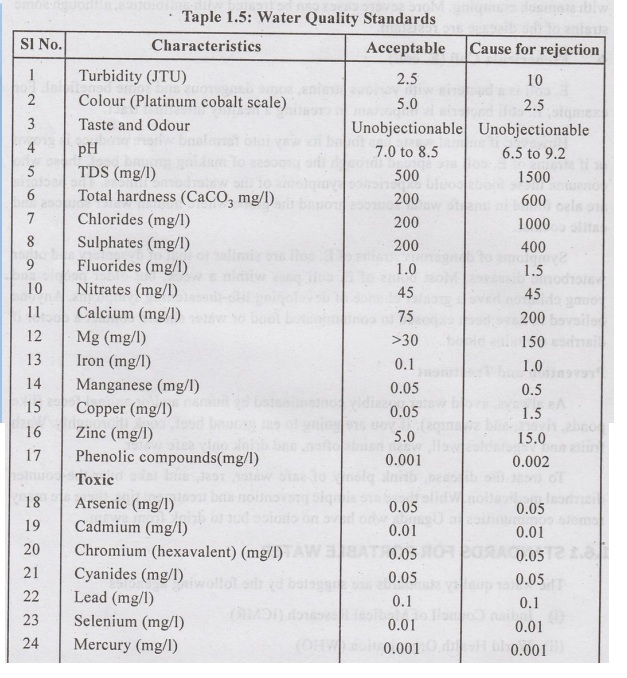Water Supply And Wastewater Engineering: Unit I: Water Supply
Water Borne Diseases
with Symptoms, Prevention and Treatment
Waterborne diseases are illnesses caused by microscopic organisms, like viruses and bacteria, which are ingested through contaminated water or by coming in contact with feces.
WATER
BORNE DISEASES
Waterborne
diseases are illnesses caused by microscopic organisms, like viruses and
bacteria, which are ingested through contaminated water or by coming in contact
with feces. Water-borne diseases are the ones caused by pathogenic microbes
spread via contaminated water.
Transmission
of these pathogens occurs while using infected water for drinking, food preparation,
and washing clothes, among others. Many developing countries do not have proper
water treatment plants, especially in the rural areas. In some places, the
availability of water is so scarce that people have neither the time nor the
money to afford the water purifiers or other water treatment mechanisms.
Majority of water-borne diseases worldwide mainly affect children due to poor
hygiene and weak immunity. Most of these diseases are life-threatening. The
knowledge of the different types of water-borne diseases has come to the
forefront with the advent of globalization over the past few decades. Several
pathogenic microorganisms which were previously unknown have become the focus
of major research in this field.
❖ Typhoid Fever
Although rare in industrialized countries, typhoid fever is well-known in extremely poor parts of developing nations; it's estimated that up to 20 million people worldwide suffer from the illness each year. It's spread through contaminated food, unsafe water, and poor sanitation, and it is highly contagious.
Symptoms include:
•
A fever that increases gradually
•
Muscle aches
•
Fatigue
•
Sweating
• Diarrhea or constipation
Prevention and Treatment:
To
prevent dysentery, wash your hands with soap frequently, order all drinks without
ice, don’t eat food sold by street vendors, and only eat fruits you can peel.
Drink only bottled and sealed, and do
not eat food from villages or street vendors. Typhoid is treated with
antibiotics.
❖ Cholera
Cholera is commonly found in humanitarian emergencies or marginalized villages where poverty and poor sanitation are rampant. The disease is spread through contaminated water and causes severe dehydration and diarrhea. Cholera can be fatal within days or even hours of exposure to the bacteria, but only 1 in 10 people will develop life-threatening symptoms.
Symptoms include:
•
Nausea
•
Vomiting
•
Diarrhea
•
Muscle cramps
Prevention and Treatment:
Cholera
is a waterborne illness that's easily prevented when traveling. Wash your hands
often, only eat foods that are completely cooked and hot (no sushi), and only
eat vegetables you can peel yourself, like avocados, bananas, and oranges. Of
course, drink safe water.
❖ Dysentery
An intestinal infection, dysentery is a waterborne disease characterized by severe diarrhea as well as blood or mucus in the stool. Dysentery is good reason to always wash your hands, as the disease is spread mainly through poor hygiene. It can be caused by bacteria, viruses, or parasites in unsafe food and water and by people coming in contact with fecal matter. If someone experiencing dysentery cannot replace fluids quickly enough, their life could be at risk.
Symptoms
include:
•
Stomach cramps and pain
•
Diarrhea
•
Fever
•
Nausea
•
Vomiting
• Dehydration
Prevention and Treatment
To
prevent dysentery, wash your hands with soap frequently,order all drinks without ice, don’t food sold by street
vendors, and only eat fruits you can peel. Drink only sealed bottled water while traveling in places with higher
dysentery risk, such as communities where proper hygiene practices are
uncommon. Mild dysentery usually clears up with rest and fluids, but
over-the-counter medications such as Pepto-Bismol can help with stomach
cramping. More severe cases can be treated with antibiotics, although some
strains of the disease are resistant.
❖ Escherichia
Coli
E.
coli is a bacteria with various strains, some dangerous and some beneficial.
For example, E. coli bacteria is important in creating a healthy intestinal
tract.
However,
if animal waste has found its way into farmland where produce is grown or if
strains of E. coli are spread through the process of making ground beef, those
who consume these foods could experience symptoms of the waterborne illness.
The bacteria are also found in unsafe water sources around the globe where
human water sources and cattle coexist.
Symptoms
of dangerous strains of E. coli are similar to that of dysentery and other
waterborne diseases. Most bouts of E. coli pass within a week, but older people
and young children have a greater chance of developing life-threatening
symptoms. Anyone believed to have been exposed to contaminated food or water
should contact a doctor if diarrhea contains blood.
Prevention and Treatment
As
always, avoid water possibly contaminated by human and/or animal feces (like
ponds, rivers, and swamps). If you are going to eat ground beef, cook
thoroughly. Wash fruits and vegetables well, wash hands often, and drink only
safe water.
To
treat the disease, drink plenty of safe water, rest, and take over-the-counter
diarrheal medication. While these are simple prevention and treatment tips,
there are many remote communities in Uganda who have no choice but to drink
from swam.
STANDARDS FOR
PORTABLE WATER
The
water quality standards are suggeted by the following agencies
(i)
Indian Council of Medical Research (ICMR)
(ii)
World Health Organisation (WHO)
(iii)
United States Public Health Society (U.S.P.H.S.)
(iv)
American Water Works Association (A.W.W.A)
The
Central Public Health and Environmental
Engineering Organisation (CPHEEO) the "The
Ministry of Urban Development" (MUD) India has prepared the Manual on
water supply and treatment in which water quality standards have been laid
down.

Water Supply And Wastewater Engineering: Unit I: Water Supply : Tag: : with Symptoms, Prevention and Treatment - Water Borne Diseases
Related Topics
Related Subjects
Water Supply and Wastewater Engineering
CE3303 3rd Semester Civil Dept 2021 Regulation | Tag: 3rd Semester Civil Dept 2021 Regulation
